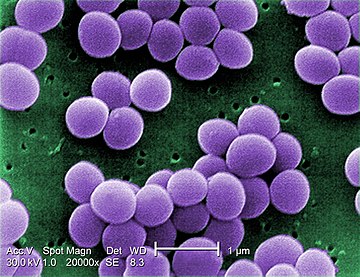¿Lo sabías?
Puedes hacer doble clic en una palabra para buscarla en TermGallery.
Puedes hacer doble clic en una palabra para buscarla en TermGallery.
Significados de staphylococcus aureus en inglés

Sinónimos
Examples for "s. aureus"
Examples for "s. aureus"
1
Conclusion: Sodium heparin lacked antibacterial activity against S. aureus causing catheter-related infections.
2
S. aureus is known to induce type 2 cytokine release via enterotoxins.
3
A biofilm-negative phase-variant S. aureus strain was detected from 6 strains tested.
4
In the absence of loricrin, S. aureus nasal colonisation was significantly impaired.
5
The antibiofilm properties of ScpA were conserved across S. aureus strain lineages.
Uso de staphylococcus aureus en inglés
1
The swab test results were finalised the following day, showing "heavy growth of staphylococcus aureus".
2
Biopsy results demonstrated the presence of staphylococcus aureus in the child and no organisms in the adult.
3
MRSA (methicillin-resistant staphylococcus aureus) is a bacteria resistant to many antibiotics that can result in fatal infections.
4
MRSA stands for a particular strain of the bacteria, staphylococcus aureus, that has become resistant to treatment with the antibiotic, methicillin.
5
Another, from Romania, wrote: I have some big problems in my life because of staphylococcus aureus...
6
One of the donors, records show, carried staphylococcus aureus, an infection the CDC website says poses a potentially serious risk to healthcare workers.
7
Methicillin-resistiant staphylococcus aureus (MRSA) is a particular strain of the common staphylococcus aureus bacterium which can live in noses and on human skin.
8
Most units screened for methicillin-resistant staphylococcus aureus prior to surgery but fewer than 1 in 3 screened for methicillin-sensitive strains.
9
Biofilm formation by Staphylococcus aureus is a serious problem in nosocomial infections.
10
Methicillin resistance creates a major obstacle for treatment of Staphylococcus aureus infections.
11
It was recently found to contribute to the virulence of Staphylococcus aureus.
12
Staphylococcus aureus is an opportunistic pathogen that causes acute and chronic infections.
13
During this period, methicillin-resistant Staphylococcus aureus was predominantly cultured from the trachea.
14
Staphylococcus aureus is the most prevalent pathogen causing mastitis of dairy ruminants.
15
It behaves like and can be mistaken in culture for Staphylococcus aureus.
16
Staphylococcus aureus enterotoxins are potent T-cell mitogens capable of triggering life-threatening shock.
Esta colocación está formada por:
Translations for staphylococcus aureus
Staphylococcus aureus a través del tiempo
Staphylococcus aureus por variante geográfica

Estados Unidos de América
Común

